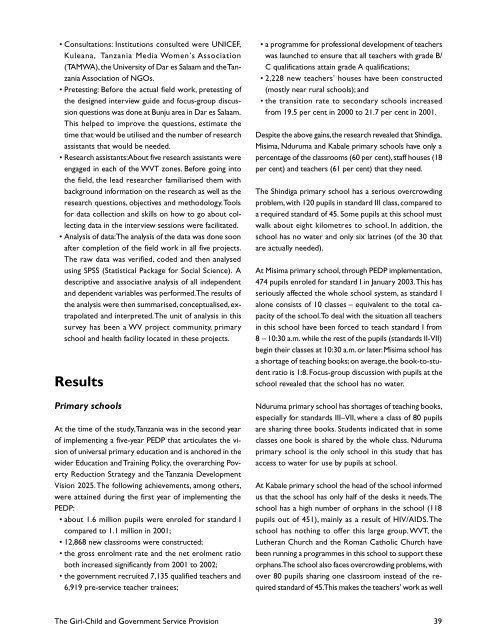The Girl-Child and Government Service Provision.pdf - Tanzania ...
The Girl-Child and Government Service Provision.pdf - Tanzania ...
The Girl-Child and Government Service Provision.pdf - Tanzania ...
- No tags were found...
Create successful ePaper yourself
Turn your PDF publications into a flip-book with our unique Google optimized e-Paper software.
• Consultations: Institutions consulted were UNICEF,Kuleana, <strong>Tanzania</strong> Media Women’s Association(TAMWA), the University of Dar es Salaam <strong>and</strong> the <strong>Tanzania</strong>Association of NGOs.• Pretesting: Before the actual field work, pretesting ofthe designed interview guide <strong>and</strong> focus-group discussionquestions was done at Bunju area in Dar es Salaam.This helped to improve the questions, estimate thetime that would be utilised <strong>and</strong> the number of researchassistants that would be needed.• Research assistants: About five research assistants wereengaged in each of the WVT zones. Before going intothe field, the lead researcher familiarised them withbackground information on the research as well as theresearch questions, objectives <strong>and</strong> methodology. Toolsfor data collection <strong>and</strong> skills on how to go about collectingdata in the interview sessions were facilitated.• Analysis of data: <strong>The</strong> analysis of the data was done soonafter completion of the field work in all five projects.<strong>The</strong> raw data was verified, coded <strong>and</strong> then analysedusing SPSS (Statistical Package for Social Science). Adescriptive <strong>and</strong> associative analysis of all independent<strong>and</strong> dependent variables was performed. <strong>The</strong> results ofthe analysis were then summarised, conceptualised, extrapolated<strong>and</strong> interpreted. <strong>The</strong> unit of analysis in thissurvey has been a WV project community, primaryschool <strong>and</strong> health facility located in these projects.ResultsPrimary schoolsAt the time of the study, <strong>Tanzania</strong> was in the second yearof implementing a five-year PEDP that articulates the visionof universal primary education <strong>and</strong> is anchored in thewider Education <strong>and</strong> Training Policy, the overarching PovertyReduction Strategy <strong>and</strong> the <strong>Tanzania</strong> DevelopmentVision 2025. <strong>The</strong> following achievements, among others,were attained during the first year of implementing thePEDP:• about 1.6 million pupils were enroled for st<strong>and</strong>ard Icompared to 1.1 million in 2001;• 12,868 new classrooms were constructed;• the gross enrolment rate <strong>and</strong> the net erolment ratioboth increased significantly from 2001 to 2002;• the government recruited 7,135 qualified teachers <strong>and</strong>6,919 pre-service teacher trainees;• a programme for professional development of teacherswas launched to ensure that all teachers with grade B/C qualifications attain grade A qualifications;• 2,228 new teachers’ houses have been constructed(mostly near rural schools); <strong>and</strong>• the transition rate to secondary schools increasedfrom 19.5 per cent in 2000 to 21.7 per cent in 2001.Despite the above gains, the research revealed that Shindiga,Misima, Nduruma <strong>and</strong> Kabale primary schools have only apercentage of the classrooms (60 per cent), staff houses (18per cent) <strong>and</strong> teachers (61 per cent) that they need.<strong>The</strong> Shindiga primary school has a serious overcrowdingproblem, with 120 pupils in st<strong>and</strong>ard III class, compared toa required st<strong>and</strong>ard of 45. Some pupils at this school mustwalk about eight kilometres to school. In addition, theschool has no water <strong>and</strong> only six latrines (of the 30 thatare actually needed).At Misima primary school, through PEDP implementation,474 pupils enroled for st<strong>and</strong>ard I in January 2003. This hasseriously affected the whole school system, as st<strong>and</strong>ard Ialone consists of 10 classes – equivalent to the total capacityof the school. To deal with the situation all teachersin this school have been forced to teach st<strong>and</strong>ard I from8 – 10:30 a.m. while the rest of the pupils (st<strong>and</strong>ards II-VII)begin their classes at 10:30 a.m. or later. Misima school hasa shortage of teaching books; on average, the book-to-studentratio is 1:8. Focus-group discussion with pupils at theschool revealed that the school has no water.Nduruma primary school has shortages of teaching books,especially for st<strong>and</strong>ards III–VII, where a class of 80 pupilsare sharing three books. Students indicated that in someclasses one book is shared by the whole class. Ndurumaprimary school is the only school in this study that hasaccess to water for use by pupils at school.At Kabale primary school the head of the school informedus that the school has only half of the desks it needs. <strong>The</strong>school has a high number of orphans in the school (118pupils out of 451), mainly as a result of HIV/AIDS. <strong>The</strong>school has nothing to offer this large group. WVT, theLutheran Church <strong>and</strong> the Roman Catholic Church havebeen running a programmes in this school to support theseorphans. <strong>The</strong> school also faces overcrowding problems, withover 80 pupils sharing one classroom instead of the requiredst<strong>and</strong>ard of 45. This makes the teachers’ work as well<strong>The</strong> <strong>Girl</strong>-<strong>Child</strong> <strong>and</strong> <strong>Government</strong> <strong>Service</strong> <strong>Provision</strong> 39
















